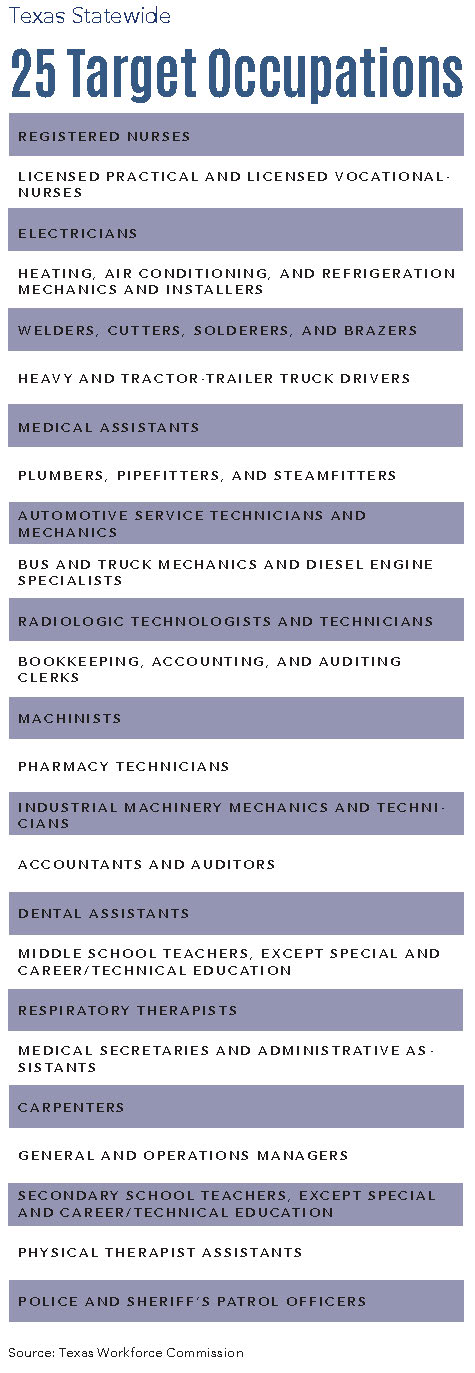Expanding companies aren’t the only ones enticed by Texas’ business-friendly climate.
“Having that kind of reputation also tends to draw workers. They see the industry moving, they need a good job, and they come to the state. We are leading other states in population growth,” says Courtney Arbour, the director of the Texas Workforce Commission’s Workforce Development Division. “In fact, we are the top state attracting young people 25 to 39 years of age.”
Not only did the Texas population grow by nearly half a million people in 2023, Arbour shared that 82% of people born in Texas choose to stay there.
“We jokingly say that we are the stickiest state,” explains Arbour. “And that helps to create an environment where we have an ample workforce to support the job growth we’ve experienced.”
With locals that like to stick around and a steady stream of newcomers, Texas’ workforce has grown to more than 15 million people, a much needed asset given the influx of job opportunities in every region.
Due to the state’s business climate attracting hordes of corporate expansion projects, Texas is projected to add more than 2.3 million new jobs between 2020 and 2030. In 2023 alone, approximately 326,700 nonfarm jobs were created, more than any other state in the nation, according to data from the Bureau of Labor Statistics (BLS).
While the sheer size of Texas’ workforce has certainly played a role in cementing this success, its dynamic approach to addressing talent gaps and upskilling efforts has assured companies that they can find and create the workers they need in Texas.
“We have long been an integrated system at the Texas Workforce Commission, where we have multiple workforce programs from federal and state sources operating within this agency. And because of our integration, we are able to serve a lot of Texans, providing a lot of different types of services,” says Arbour. “We have longstanding partnerships that help us to find workers and connect them to jobs or connect them to training or with higher education.”
Alongside 28 Workforce Development Boards, the Texas Workforce Commission is a part of a statewide resource known as the Texas Workforce Solutions network. More than 170 Workforce Solutions offices are peppered throughout the state, providing residents access to career training, financial aid, job-search tools and support services such as interview clothing, gas cards and bus tickets.
“Whatever it takes to help connect those workers,” says Arbour. “Because there are more than 170 local offices, we are well connected in the communities and with industries to know the workforce needs.”
 Workers in San Antonio enjoy congregating at the end of the day at the Hotel Emma bar.
Workers in San Antonio enjoy congregating at the end of the day at the Hotel Emma bar.
Photo by Pierce Ingram/Courtesy of Travel Texas
Tackling the Talent Crisis
 Arbour states that in recent years TWC has actively prioritized addressing talent gaps in the middle skill jobs, occupations that do not require a bachelor’s degree, but still some level of certification following high school.
Arbour states that in recent years TWC has actively prioritized addressing talent gaps in the middle skill jobs, occupations that do not require a bachelor’s degree, but still some level of certification following high school.
“We saw that after COVID, with the great reshuffling of people leaving certain jobs and moving into others, middle skills jobs are those that really keep the economy churning,” says Arbour. “TWC is focused on ensuring that workers know of these jobs in their area, not only the jobs today, but also those with projected growth in the years ahead.”
Increasing the funding and opportunities for apprenticeship programs has been integral to these efforts.
“Apprenticeship programs are both a job seeker benefit and an employer benefit,” says Arbour. “When an apprenticeship program takes off, not only are the workers being trained on the job so they don’t have to leave employment to go into a training program, but also the employer is able to secure their workforce early on and keep them for a longer period.”
In 2022, TWC set side aside $4 million to support employers who were creating or already using Registered Apprenticeship (RA) programs to train their workers in middle skill careers. The organization has continued to bolster these efforts through multiple initiatives.
Until December 31, 2026, companies approved for the Apprenticeship Tax Refund Pilot Program could potentially receive a refund on their state taxes of up to $2,500 for each apprentice participating in a qualifying apprenticeship program who has earned wages for at least seven months over a one-year period.
In January, TWC announced a new apprenticeship initiative for eligible private sector employers. The Texas Industry Recognized Apprenticeship (TIRA) program plans to award nearly $10 million in grants during this initial round. To qualify for this opportunity, private-sector companies must develop or grow an apprenticeship model that aligns with one of the high-demand target occupations. Apprenticeships for carpenters, automotive service technicians and mechanics, electricians, bus and truck mechanics and diesel engine specialists, bookkeepers, accountants and auditors as well as a range of jobs in health care are among those that are eligible to receive funding.
“The important part of an apprenticeship is that it’s a paid model, so that people don’t have to leave a job to be upskilled,” says Arbour. “We have assisted in the training of more than 46,000 apprentices in the last five years. Apprentices are full-time paid employees. They are earning while they learn. There is a classroom component and also an on-the-job component where an apprentice is provided very structured training and a predictable training outlook, so they know the different milestones they’ll be passing along the way.”

